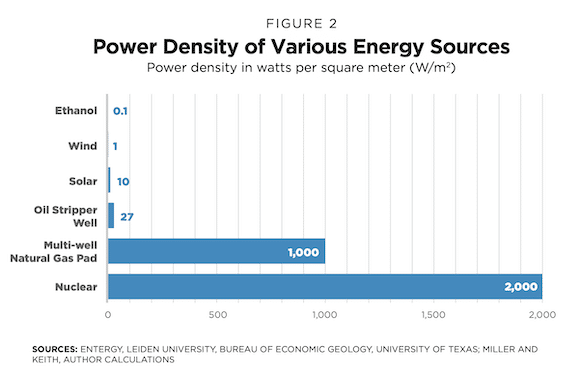
You “cannot power the world with solar panels and wind turbines alone.” So said Energy Committee ranking member Senator John Barrasso (R-Wy.) during the recent American Nuclear Society winter conference in Washington, D.C. Barrasso was reaffirming his support for nuclear energy, and in this was joined by the committee’s chairman, Democrat Senator Joe Manchin of West Virginia.
The two senators emphasized that the United States must produce more energy and not be reliant on foreign nations. The Daily Caller reported on the story Wednesday, writing:
“The reality is that you cannot power the world with solar panels and wind turbines alone,” Barrasso said during his remarks. “The demands for energy worldwide are going to continue to increase. Not just in the United States, [sic] you’re gonna see that worldwide.”
“Every time we use energy, we’re using it more efficiently, but you still have increased demands,” the Wyoming Republican added. “Nuclear has to be a very, very important part of that.”
Barrasso said more members of Congress should support nuclear energy because of its efficiency and built-in storage systems unlike solar and wind power.
“It is smaller, it’s more efficient and includes an energy storage system when the wind isn’t blowing and the sun isn’t shining,” he said.
In July, Barrasso was among a bipartisan group of senators who introduced the American Nuclear Infrastructure Act (ANIA), which will “improve the nation’s nuclear infrastructure, secure America’s uranium supply chain, grow the economy, create jobs, reduce carbon emissions, and strengthen our energy and national security,” according to the website of Senator Shelley Moore Capito (R-W.Va.).
The Caller informs that the ANIA was included in the so-called infrastructure package Joe Biden signed into law last month.
As for Manchin, he trumpeted the legislation recently, saying that it represented progress in improving nuclear infrastructure. “I will continue pushing for the inclusion of funding for the advanced nuclear fuel availability program,” the Caller reports him as having stated during a pre-recorded American Nuclear Society speech. “As you know, proper funding of this program will ensure a domestic supply of high-assay low-enriched uranium, eliminating reliance on Russia or other foreign suppliers.”
Of course, the Left despises nuclear energy as it does fossil fuels (in other words, anything that actually works), and many other Americans find the technology scary. Just hearing the term “nuclear” or “atomic” conjures up for many people thoughts of radioactive fallout or a mutagenic yellow cloud in movies, à la The Incredible Shrinking Man. (In reality, radiation is colorless.)
But as a friend who works for an energy company once told me — and no, he doesn’t have a vested interest in pushing nuclear — atomic energy is the world’s cleanest currently viable form of energy.
You don’t have to tell this to France — it derives 70.6 percent of its total electricity from nuclear. And leading the world in this category, interestingly, is Slovakia: Its nuke/juice figure is 82.3 percent.
This said, Joe Manchin and others are pushing nuclear as a solution to the climate-change “crisis,” which it can’t be for a simple reason:
That crisis doesn’t exist.
The New American has made this case repeatedly (such as here, here, here, and here). The climate alarmists should hope we’re correct, too, and this is also for a simple reason:
The world isn’t going to be reducing CO2 emissions anytime soon. In fact, while China talks a good game about doing so — mainly to con Western nations into hobbling their economies — it’s busy building new coal plants at a feverish pace. India, the world’s second most populous country, is also constructing such plants.
These nations reject the solar-and-wind hot air because they know the truth of what Powerline wrote in April: “Wind and solar energy are both essentially obsolete technologies.”
This is largely because they’re low-intensity energy sources; meaning, they don’t produce very much wattage per square meter (chart below). Thus would it require, for example, a region three times California’s size to meet the U.S.’s current energy needs with wind power, according to this analysis.

This doesn’t mean we won’t one day have a clean, economical alternative energy source; that is, as long as a descent into socialism doesn’t stifle innovation. For it’s only a healthy market, with its incentives, that catalyzes the creative capacities of the common man. It is this that can bring tomorrow’s technological wonders and, when that new, viable energy source is birthed, its effectuation won’t require government coercion.
But that’s in the future. As for now, remembering the past is wise. Back in the ‘90s, we lamented our reliance on foreign energy sources and complained about enriching Mideast sheiks and indirectly funding terrorism. Becoming energy independent seemed like an impossible dream. Yet American innovation and market incentives made it a reality; what’s more, we transformed ourselves into one of the world’s largest energy exporters.
Now the Biden administration threatens this, our most successful economic sector, with greentopian fantasies that will only enrich one group: establishment-connected con artists who make green off the green (see Solyndra et al.).
As for the fear “nuclear” evokes (even when pronouncing it “nu-cu-lar,” G.W. Bush style), perhaps we can learn from the history of what was originally called “Nuclear Magnetic Resonance.” After it was realized that this name scared people, the technology was rebranded “Magnetic Resonance Imaging.” Yes, that’s the MRI you’ve probably had in a hospital.
So perhaps we can call nuclear “Particle Chain Reaction Energy.”


